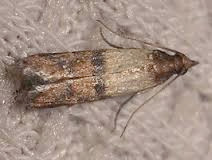ManageSafe
Least-Toxic Control of Pantry Moths Choose a different pests

|
Factsheet: Pests in the Pantry, Clearing the Air of Toxic Moth Repellents
Identification
Pest type: Insects
The adult pantry moth is a small moth, about 3/8 inch long with a wing span of about 5/8 inch/ The overall body color is generally dirty gray but the tip half of the wing is rusty brown or nearly bronze.
Is it a problem?
Pantry moths can lay several hunderd eggs. The eggs will hatch, feed, feed, and infest the other food in your cabinet. Products including flour, whole grains, crackers, peas, beans, nuts, dried fruit, spices and even pet food are attractive to moths.
Pest prevention practices
Store food in air-tight, sealed containers
Keep infested food out of your house, and you keep moths from invading. Always inspect your groceries for infestation.
Check out packaging while at the grocery store, looking for signals of moth and larva presence, such as small holes when buying bulk grains, and keep your eye out for any insects in the food.
Store all of your food in tightly sealed containers. This will keep any pantry pest that slipped through your inspection from infesting other food in your kitchen -- glass jars with lids that have rubber gaskets are an excellent choice. Beware that jars with screw tops may not be sufficient against pantry pest invasion.
Clean up all spills and crubs promptly. If you notice cracks and crevices where crumbs tend to become lodged, use caulk to seal these up.
Cupboards and shelves should fit flush against cabinet walls s as not to provide spaces for crumbs to accummulate
Make sure that other areas that attract crumbs, such as in the toaster, stay clean.
Monitoring and record-keeping
Keep an eye out for signs of moths (small holes in packaging) in your groceries, and try to monitor older baking supplies when rummaging through the kitchen.
Non-chemical and mechanical controls
Repair holes
Sticky traps
Remove clutter
Vacuum
Discard the infested food in sealed bags outside of your home or use temperature manipulation described above to kill off the insects. Remember to sift them out of the food afterwards.
If you store larger than normal quantities of grain that become infested, you can use Bacillus thuringiensis (Bt) to manage the problem. Apply only to the surface, since these pests usually will not go deeper than four inches into the grain.
Once the food in your pantry is moth-free, thoroughly clean the infested area. Use soap and hot water in your pantry, paying special attention to corners and crevices.
Take all cans out and wash them as well to kill and microscopic larvae.
Vacuum any infested areas in the kitchen.
Take the preventitive measures described aboce and monitor the problem after clean up.
Pheromone traps can be used to kill any leftover moths and to monitor their population. These traps are normally effective for about three months. If you notice an increase in the number of moths in your traps, it is time to inspect your food again.
Without having to buy any supplies, you can just leave your kitchen light on at night, with all other lights in the house off. You can capture the stray moth when it comes out from its hiding spot to the light.
Biological controls
Biological controls are not effective for least toxic control of pantry months indoors.
Least-toxic chemical options as a last resort
Insecticidal soaps can be used to wash down the cabinents. Additionally, there are a range of moth traps that are available and effective including pheromone moth traps, sticky glue traps and glue bait moth tents.
Chemicals to Avoid
Look at your product labels and try to avoid products containing those chemicals listed below:
(A = acute health effects, C = chronic health effects, SW = surface water contaminant, GW = ground water contaminant, W = wildlife poison, B = bee poison, LT = long-range transport)
|
Chlorfenapyr | Deltamethrin | Etofenprox |
Social Media
See what other folks are saying about this, and let us know what works for you.
Click the post above to view and comment on Facebook, or comment directly on this site below.








